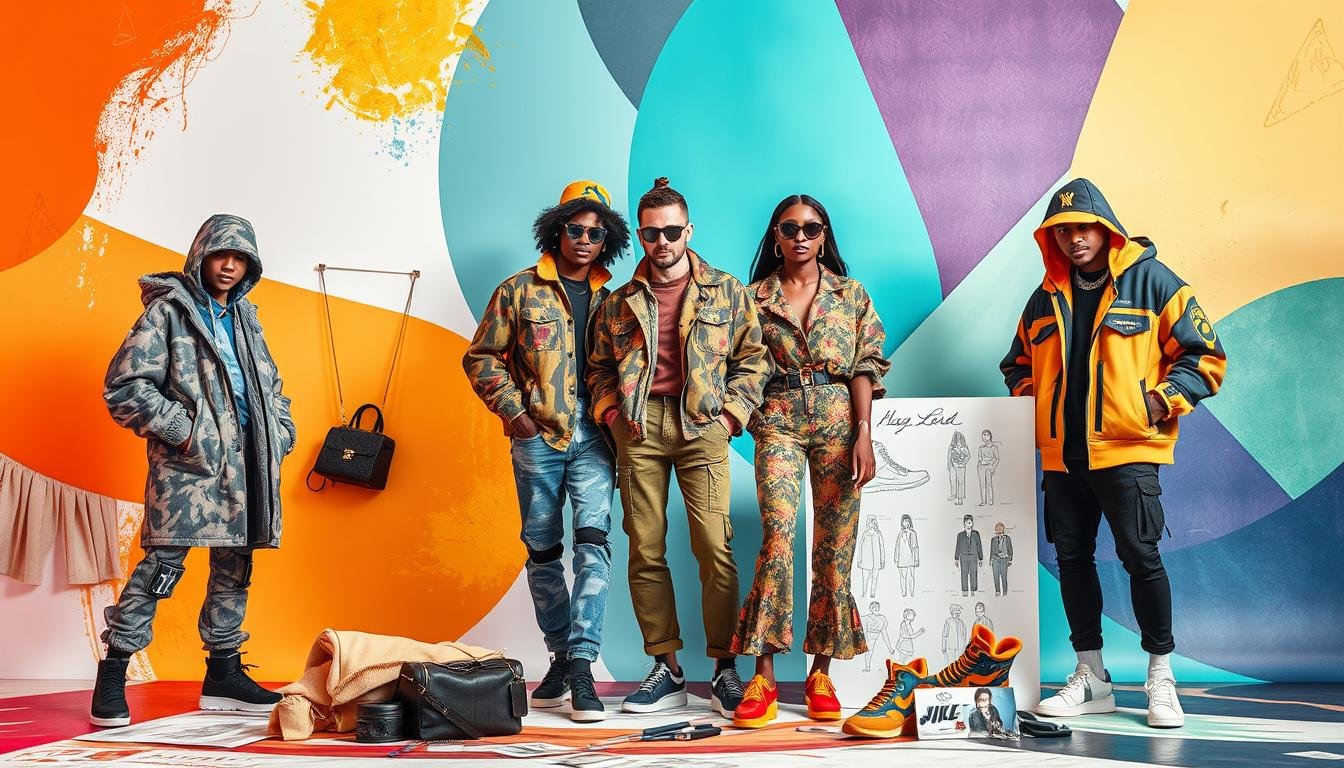Designer collaborations are key in the fashion world, mixing creativity and business. They bring together fashion and art, just like Yves Saint Laurent’s Mondrian collection and Elsa Schiaparelli’s work with Jean Cocteau and Salvador Dalí. These partnerships have grown from simple fashion-art mix-ups to exciting digital projects, changing how we see fashion and what we expect from it.
Now, designer collaborations go beyond old limits. Luxury brands team up with modern artists, streetwear, and digital creators. This has made fashion more accessible, bringing top designs to everyone. It’s ushered in a new age where fashion and art meet in exciting ways.
Key Takeaways
- Designer collaborations have become a defining trend in the fashion industry, blending creativity and commerce.
- The fusion of fashion and art has a rich history, from Yves Saint Laurent’s Mondrian collection to Elsa Schiaparelli’s surreal designs.
- Modern designer collaborations have evolved beyond traditional fashion-art crossovers, embracing digital experiences and forging strategic alliances.
- Collaborations have democratized fashion, bringing high-end designs to the masses and fostering a new era of fashion-art convergence.
- The success of designer collaborations lies in their ability to create unique, desirable, and often limited-edition products that capture the imagination of consumers.
The Evolution of Fashion and Art Partnerships
Fashion and art have been connected for over a century. Famous partnerships like Yves Saint Laurent’s Mondrian collection and Elsa Schiaparelli’s work with Salvador Dalí paved the way. The shift from fashion illustrations to photography also mixed these two worlds.
Historical Roots in Fashion-Art Fusion
The 1930s were key for fashion and art coming together. Elsa Schiaparelli and Salvador Dalí created eye-catching clothes, like the Organza Dress With Painted Lobster. These pieces are landmarks in the history of fashion and art.
Notable Early Collaborations
- In the 1960s, Pop Art brought us Andy Warhol’s “The Souper Dress” and Yves Saint Laurent’s Mondrian Dress.
- The 1980s saw fashion shows in museums, showing fashion’s cultural importance. This led to more themed exhibitions.
- In the late 1980s and 1990s, designers like Hussein Chalayan and Rei Kawakubo focused on ideas over sales. Their shows became like art performances.
Impact on Modern Fashion
The 2001 partnership between Louis Vuitton and Stephen Sprouse started a trend of artist-fashion collaborations. Marc Jacobs‘ work with artists like Jeff Koons and Yayoi Kusama has also made a big impact. These collaborations have changed how fashion brands market themselves.
“The 2020 Prada Flowers Resort campaign showed a mix of fashion and art. It was a project with photographer Drew Vickers and street photographer Keizō Kitajima.”
Understanding Designer Collaborations in Today’s Fashion Landscape
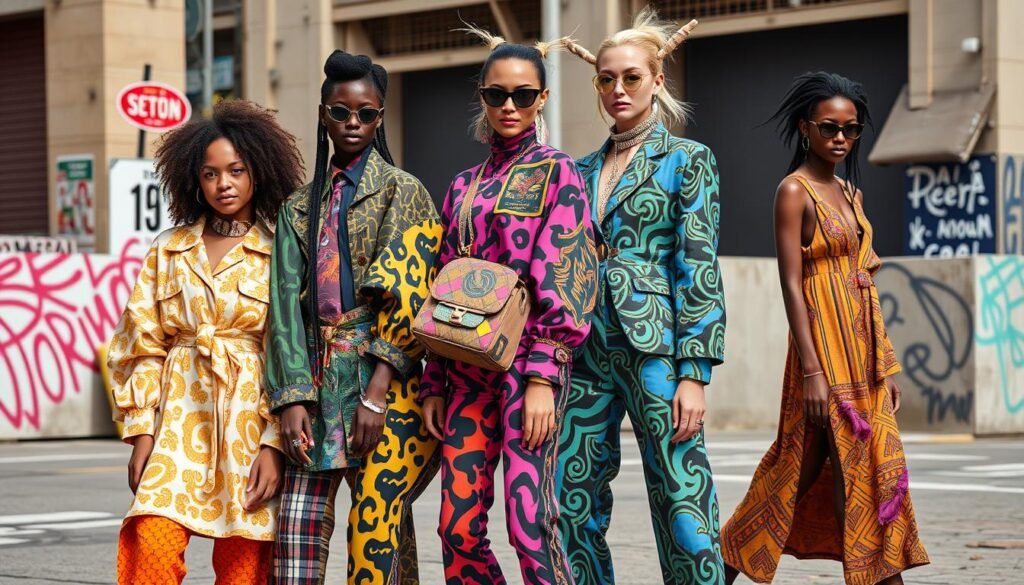
In the world of fashion, designer collaborations are all the rage. They bring together luxury brands, artists, celebrities, and even fast-fashion retailers. These partnerships help brands reach new fans, refresh their image, and offer exclusive capsule collections.
These collaborations go beyond clothes. They include accessories, beauty products, and home goods. They’re key to a brand’s strategy, helping them connect with different people and stay current.
| Collaboration | Details |
|---|---|
| Target x Christopher John Rogers | In May 2021, Target released a limited-edition collection of dresses designed by Christopher John Rogers. |
| Prada x Raf Simons | The collaboration between Miuccia Prada and Raf Simons was announced back in 2020. |
| Versace x Fendi | In 2021, Versace and Fendi collaborated on a collection named “The Swap.” |
| Gucci x Adidas | Gucci partnered with Adidas for its Fall 2022 collection. |
| Etro x Harris Reed | In 2021, Italian luxury house Etro collaborated with emerging designer Harris Reed. |
The 2010s brought back Versace’s diffusion line, Versus Versace. It teamed up with designers like Christopher Kane and JW Anderson. Donatella Versace aimed to support young talent in luxury fashion.
Today, designer collaborations are a big part of the fashion world. They help brands reach new markets, create excitement, and meet changing fashion tastes.
High-End Meets High Street: The Democratization of Fashion
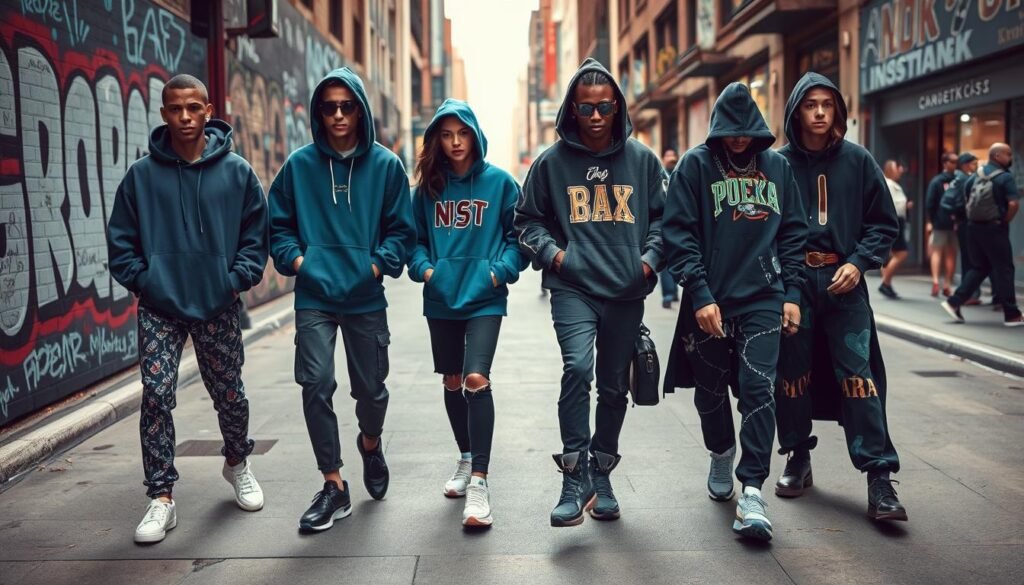
Fashion has changed a lot, thanks to the mix of luxury and affordable clothes. Brands like H&M, Uniqlo, and Gap X have teamed up with top designers. This has made designer clothes more available, changing the fashion world.
Luxury Brands x Fast Fashion
H&M has worked with big names like Balmain and Karl Lagerfeld. Uniqlo has also partnered with top brands. These collections sell out fast, showing how much people want them.
Success Stories and Market Impact
These partnerships have made a big difference. Luxury brands get more attention, and fast-fashion stores look better. This mix has changed the fashion world, making it more open to everyone.
Consumer Response to Collaborative Collections
People love these special collections. They wait in line or online to get the latest items. This shows how much they want to wear the latest designer fashion.
“The democratization of fashion has been a game-changer, empowering more people to express their personal style through high-quality, on-trend pieces.”
Creative Process Behind Fashion Partnerships
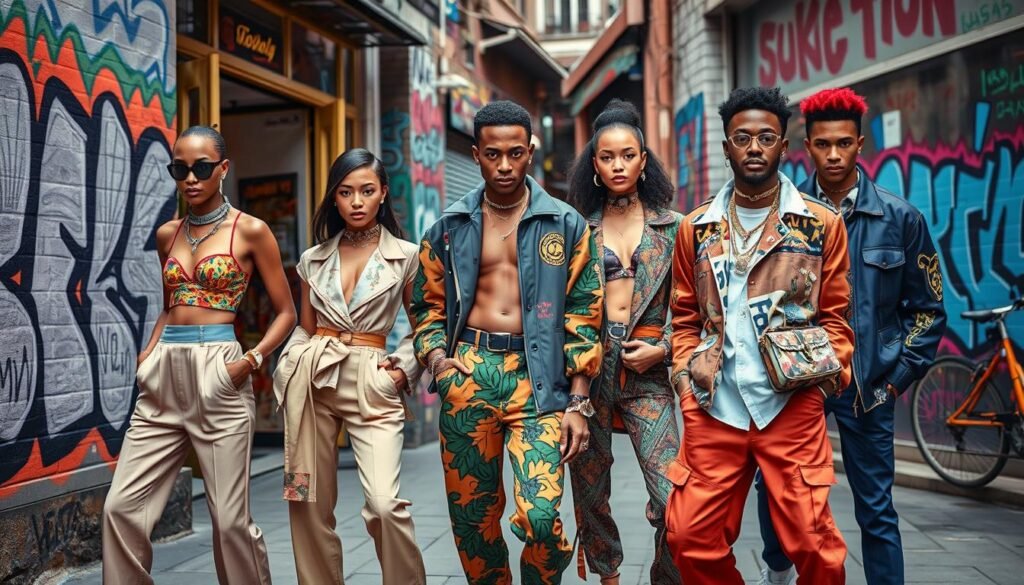
The creative process in fashion collaborations is a complex mix of different styles and visions. Designers and creative directors come together to create something new and exciting. They do this by researching, mood boarding, and prototyping to make their idea a reality.
Some partnerships focus on specific items like footwear. Others aim to create full capsule collections. The goal is to make pieces that fit both brands’ styles, offering something unique to customers. It’s a fine balance that needs tailors, stylists, and a deep understanding of what will appeal to the audience.
“Collaboration is key in today’s fast-paced fashion landscape. By combining our unique creative visions, we’re able to push the boundaries of what’s possible and deliver collections that truly stand out.” – Jane Doe, Creative Director at XYZ Fashion House
The success of a fashion partnership depends on combining each person’s strengths well. From the start to the end, it’s important to communicate openly and innovate together. This way, they create collections that hit the mark and make a lasting impression.
As fashion keeps changing, the creative process in collaborations will also evolve. It will focus more on sustainability, partnerships across different fields, and experiences that connect with customers on a deeper level.
Digital Revolution in Designer Collaborations
The digital revolution has changed how designer collaborations work. It brings new uses for AR (augmented reality) and virtual fashion. Companies like Popul-AR are making custom AR filters for fashion brands. This lets people try on clothes virtually from home.
These virtual fashion experiences are changing how we shop for designer clothes. It’s a new way to engage with fashion.
AR and Virtual Fashion
Brands like Carlings are leading the way in digital fashion. They have collections that only exist online. This approach challenges old ways of thinking about fashion.
Carlings uses digital platforms and virtual try-ons to connect with customers. They also focus on sustainability, reducing the environmental impact of clothes.
Nike has also entered the digital world, creating digital sneakers and NFTs. They use AR to make online shopping better. This combines digital fashion with sports, using wearable tech and tracking solutions.
Social Media Impact
Social media is key for promoting and selling fashion collaborations. Luxury brands like Gucci are teaming up with gaming platforms. They offer digital fashion items for avatars, reaching more people.
Platforms like Roblox let users show off their style with customizable avatars. This has become a place for user-generated fashion content. It shapes trends in the game. Fashion brands are using this to explore new digital marketing ways.
Future of Digital Fashion Partnerships
The digital revolution is changing fashion. The future might include new experiences and holo-products, like in sci-fi movies. Sustainability is also driving the use of digital fashion, with brands like Stella McCartney leading.
The mix of fashion and tech is changing how we experience designer collaborations. It’s blending the physical and virtual worlds.
| Brand | Digital Fashion Initiatives | Impact |
|---|---|---|
| Carlings | Digital-only apparel collections, virtual try-ons | Challenging traditional fashion norms, reducing environmental impact |
| Nike | Digital sneakers, NFTs, AR-enhanced online shopping | Transcending physical boundaries, integrating digital fashion with sports |
| Gucci | Digital fashion items for avatars, AR/VR customer experiences | Broadening audience, creating engaging interactions |
| Roblox | User-generated fashion content, brand collaborations | Shaping in-game fashion trends, innovative digital marketing |
| Stella McCartney | Combining sustainability with digital innovation | Setting new standards for the future of fashion |
Cultural Impact and Commercial Success Stories
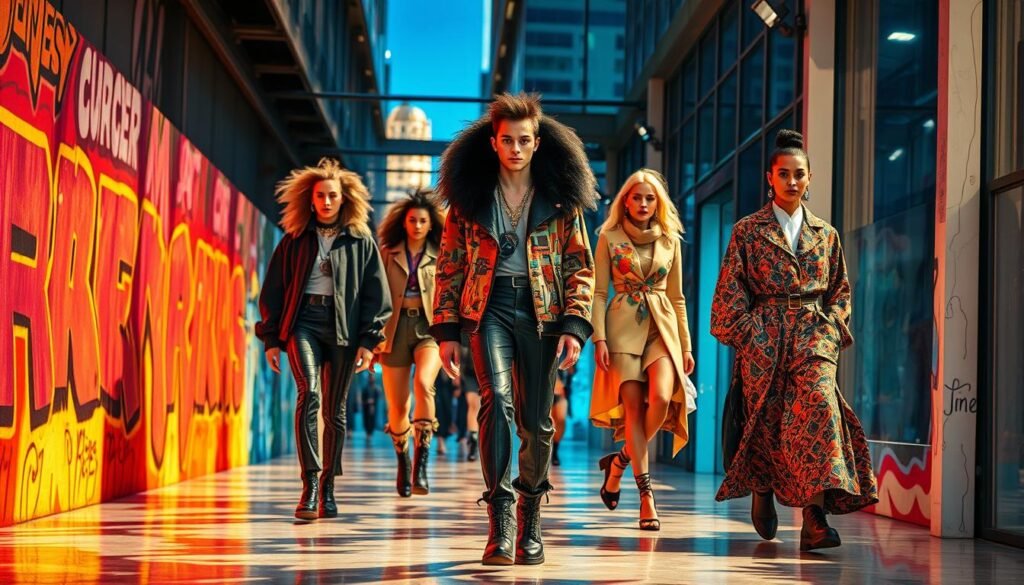
Designer collaborations have grown into more than just fashion. They’ve become cultural phenomena that grab attention globally. These partnerships can start trends, create a sense of specialness, and boost demand like never before.
The Louis Vuitton x Supreme collection is a prime example. It mixed high fashion with streetwear. It debuted at Paris Fashion Week and quickly became a cult following. It sold out fast, making it a sell-out hit. This success showed how streetwear can break through traditional fashion limits.
Rihanna’s Fenty x Puma collaboration is another standout. It combined sportswear with high fashion, showing the range of designer collaborations. Rihanna’s fame helped make the collection even more popular. She used her influence to draw attention to the collection and inspire her fans.
| Collaboration | Impact | Significance |
|---|---|---|
| Louis Vuitton x Supreme | Sold out rapidly, created a sense of exclusivity | Merged high fashion with streetwear, captivated global audience |
| Fenty x Puma | Bridged the gap between sportswear and high fashion, driven by Rihanna’s star power | Showcased the versatility and commercial success of designer collaborations |
These collaborations have also changed the fashion calendar. They’re now big events at Paris Fashion Week and British Fashion Week. The excitement and exclusivity around these partnerships have changed how people interact with fashion.
“Designer collaborations have the power to bridge the gap between high and low fashion, creating a sense of exclusivity and desirability that captivates consumers worldwide.”
As fashion keeps evolving, the impact and success of designer collaborations will keep shaping the industry. They’ll influence trends, how people shop, and the fashion world itself.
Also Read : How Does Fashion Psychology Influence Shopping Behavior?
Conclusion: The Future of Fashion Collaborations
The future of fashion collaborations is looking bright and digital. Technology will keep advancing, leading to more use of augmented reality (AR) and virtual reality (VR). We’ll also see more focus on eco-friendly materials and methods to reduce environmental impact.
The difference between physical and digital fashion might get smaller. This could open up new ways for creativity and getting people involved. Places like The Fabricant and DressX are already using tech like 3D design and NFTs to create unique digital fashion.
Designer collaborations will keep being key in shaping fashion’s future. They will drive innovation, explore new ideas, and link different worlds of fashion, tech, art, and culture. As things change, collaborations will be essential in defining the next big thing in style and innovation.
FAQs
Q: What is the significance of designer collaborations in fashion?
A: Designer collaborations, or fashion collabs, bring together different creative visions, resulting in unique collections that often blend styles and aesthetics. These partnerships can elevate a fashion label’s profile and introduce innovative concepts to the market.
Q: Can you give examples of successful collaborations, such as jimmy choo x or fenty x puma?
A: Yes! The jimmy choo x collection features chic footwear that combines elegance with contemporary design. Similarly, fenty x puma was well-received for its sleek silhouettes and bold fashion statements, showcasing the power of merging high fashion with streetwear.
Q: What can we expect from new collaborations in 2024?
A: In 2024, we anticipate several exciting brand collabs that will likely include limited edition pieces and innovative designs. Collaborations like gap x and reiss x are expected to continue, bringing fresh concepts to the runway and retail.
Q: How do collaborations like cult gaia x gap influence fashion trends?
A: Collaborations such as cult gaia x gap create a buzz in the fashion industry, influencing trends with their unique aesthetics. These partnerships often result in collections that feature oversized silhouettes and ethically made pieces, appealing to a diverse consumer base.
Q: Are there any notable collections from New York Fashion Week that highlight designer collaborations?
A: Yes, New York Fashion Week frequently showcases designer collaborations, such as the barbour x brand collabs, which create a range of stylish outerwear that merges functionality with high fashion. These events highlight how designers collaborate to redefine seasonal trends.
Q: What is the role of fashion editors in promoting designer collabs?
A: Fashion editors play a crucial role in promoting designer collabs by featuring them in editorials and online platforms. Their insights help shape public perception and can significantly boost the visibility of new collections, such as those from naomi campbell or gaultier.
Q: How do collaborations like h&m x and x pretty cater to different consumer demographics?
A: Collaborations like h&m x and x pretty are designed to reach various consumer demographics by combining affordability with high-end design. This approach allows fashion enthusiasts to access stylish pieces that reflect current trends without breaking the bank.
Q: What are some key features of a successful designer collaboration?
A: Successful designer collaborations typically include a clear vision, innovative design elements, and effective marketing strategies. For instance, collections that feature unique colourways and exclusive items, such as the reiss x collection that includes 16 pieces, tend to resonate well with consumers.
